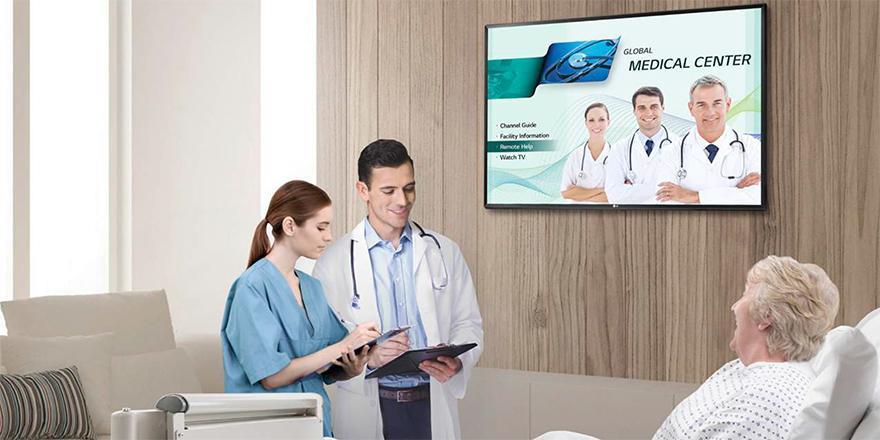The demand for quality healthcare services has never been higher than it is today. As hospitals serve patients at some of the most challenging and critical times of their lives, studies have shown better health outcomes in patients with higher satisfaction.1
An effective and efficient strategy for enhancing the patient experience is with specialized use of the patient room television. With today’s advanced technologies for increasing patient engagement via the TV, equipping the facility with purpose built, hospital grade televisions can be a major advantage for both the patient and the hospital.
What makes a hospital grade TV? Unlike consumer televisions, hospital grade televisions are engineered and constructed with a different end user in mind. Focusing on the patient needs, hospital-grade TVs are designed specifically for utilization in the patient room – with safety as the priority, reliability over extended hours of use, and customizable patient-centric applications.
Televisions for the hospital patient room, unlike consumer televisions, should adhere to stringent regulatory requirements as outlined by Underwriters Laboratories (UL). A distinct difference between hospital grade and consumer TVs is the nurse-call interface. A wired pillow speaker controls hospital grade TVs, and allows the patient to communicate with the nurses’ station, and vice-versa, while momentarily canceling the television audio to ensure clear conversation.
Hospital grade televisions also provide electronic isolation to the pillow speaker control to ensure safety in a potentially oxygen-enriched environment. Other safety features include required grounded plugs with lower levels of leakage, and all-pole power switches that decrease the likelihood of shock.
Benefits for patients – Many patients feel a loss of control when they are hospitalized, and may be afraid, uncomfortable or anxious. Giving them some sense of control and keeping them engaged and informed about their diagnosis can help elevate their mental state, and that can affect their physical state in a positive way. Hospital grade TVs can be indispensable care instruments – lending comfort as a familiar and enjoyable activity during the recovery process, providing patient-centric functions, and improving communication via patient-specific educational content.
A warm welcome screen – A friendly greeting with the facility name and logo appears on the screen when the TV is turned on. The welcome screen functions as a graphical user interface (GUI), providing an inviting, personalized and interactive experience for patients. The patient makes selections and enters information via the pillow speaker, confirming on the TV.
A wide variety of entertainment – From the welcome screen, the patient can select the Electronic Program Guide (EPG) to watch TV shows, news, rent a movie, access the web, or view Over-the-Top (OTT) Smart applications. Other options may include games, which are very popular, and a “relaxation channel,” displaying tranquil scenery accompanied by soothing music.
Patient-specific education – In the hospital, effective communication between the patient, family members and clinical team is key to a better patient experience and good outcomes. In fact, a large study of malpractice cases found that the most troublesome communication gaps are those between the provider and the patient, with 69 percent of communication cases alleging “that the patient did not receive information that he or she needed to understand their health issues, make informed decisions about treatment options, or manage their long-term care.”2
Hospitals can use the patient room TV to send the patient educational video content specific to their diagnosis and treatment, and even verify that the patient has viewed it. If the treatment calls for diet restrictions, for example, the patient can select a menu option from the welcome screen and set up their diet plan while they are in the hospital. The hospital may also provide daily updates and the discharge date on the welcome screen, as well as a patient discharge survey. At every step of the way, the TV can help engage the patient in their own care while lending an accommodating digital bedside manner.
ROI for hospitals – In addition to higher patient satisfaction and better health outcomes, hospital grade TVs can bring expanded ROI to the facility. A large portion of the ROI could come from movie rentals via access to premium HD content, monetizing with the ability to provide premium services for patients.
What’s more, today’s patient experience is related to tomorrow’s reputation. If a patient can access a variety of beneficial options on the TV to make them feel good about their hospital stay they are more likely to recommend the facility that treated them, and respond with higher ratings on HCAHPS and Press Ganey patient satisfaction surveys. Higher survey scores can impact the amount of reimbursement and funding a hospital receives and may also place the hospital in a better position regarding alignment – occasionally hospital groups consolidate and those that are more on the cutting edge are more attractive.
Have a look at LG’s Hospital Grade TVs.
1 Glickman, S. W. et al. Patient satisfaction and its relationship with clinical quality and inpatient mortality in acute myocardial infarction. Circ. Cardiovasc.Qual. Outcomes 3, 188–195 (2010). Available at https://www.ahajournals.org/doi/full/10.1161/CIRCOUTCOMES.109.900597 (last viewed 02/21/2020).
2 Jock Hoffman, CRICO and Supriya Raman, CRICO Communication Factors in Malpractice Cases (2012). Available at https://www.rmf.harvard.edu/Clinician-Resources/Newsletter-and-Publication/2012/Insight-Communication-Factors-in-Mal-Cases (last viewed 02/21/2020).
